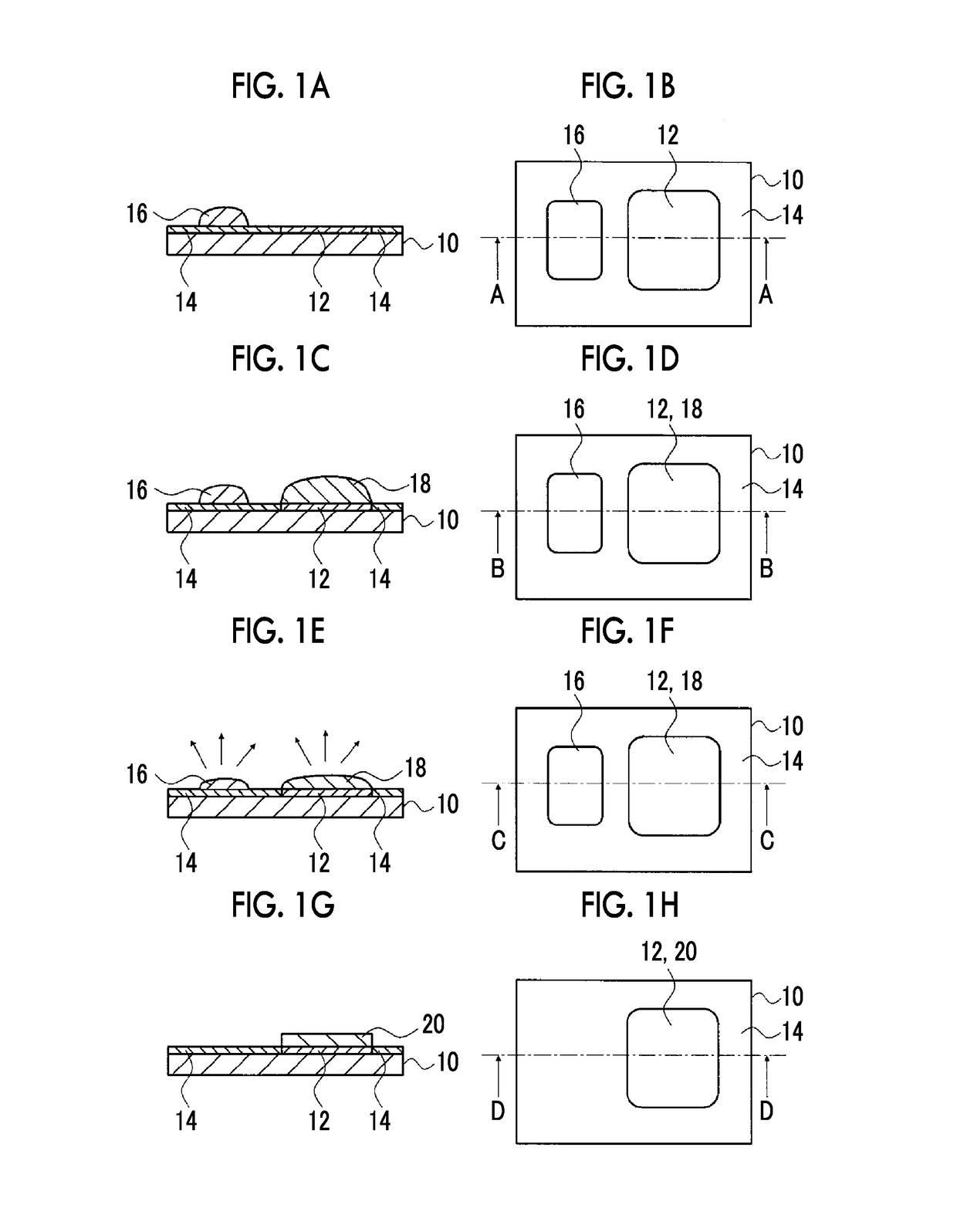Method for producing organic semiconductor film and organic transistor
- Summary
- Abstract
- Description
- Claims
- Application Information
AI Technical Summary
Benefits of technology
Problems solved by technology
Method used
Image
Examples
modification example 1
[0111]In FIGS. 1A to 1H, an embodiment in which the solvent 16 for volatilization rate control is applied to one location in the liquid repellent region 14 has been described in Step B but the present invention is not limited to the embodiment. The solvent for volatilization rate control may be applied to a plurality of locations in the liquid repellent region so as to surround the lyophilic region. Specifically, as shown in FIG. 2, the ink 18 is applied to the lyophilic region 12 on the substrate 10 and also the solvent 16 for volatilization rate control may be applied to a plurality of locations in the liquid repellent region 14 (at six locations in FIG. 2) so as to surround the lyophilic region 12. By applying the solvent for volatilization rate control to a plurality of locations as described above, the volatilization rate of the first solvent in the ink is easily controlled and the effect of the present invention is further enhanced.
[0112]The position to which the solvent for v...
modification example 2
[0115]As described above, the pattern of the lyophilic region and the liquid repellent region formed on the substrate are not particularly limited. For example, a plurality of lyophilic regions may be formed and the sizes (area) and shapes of the plurality of lyophilic regions may be different from each other.
[0116]In Step B, the amount, position, and number of locations of the solvent for volatilization rate control applied in the liquid repellent region may be adjusted according to the size (area) and shape of the lyophilic region. That is, when the solvent for volatilization rate control is applied to the liquid repellent region in the vicinity of the lyophilic region on the substrate having the plurality of lyophilic regions in which at least one of size or shape is different (size and / or shape is different) and the liquid repellent region, according to the sizes and / or shapes of the respective lyophilic regions, at least one of the amount, position, or number of locations of th...
modification example 3
[0118]As described above, the shape of the lyophilic region is not particularly limited and various shapes may be adopted.
[0119]Among these, from the viewpoint of further enhancing the effect of the present invention, the lyophilic region preferably has an ink accumulation region and an ink narrowing region (seed crystal precipitation region) connected to the ink accumulation region and having a narrower width than that of the ink accumulation region. More specifically, as shown in FIG. 4, a lyophilic region 120 and a liquid repellent region 14 are disposed on a substrate 100 and the lyophilic region 120 has an ink accumulation region 22 and an ink narrowing region 24.
[0120]When the ink is applied to the lyophilic region having two regions as described above, the ink in the ink narrowing region has a narrower width that that of the other region and thus, the solvents (the first solvent and the second solvent) included in the ink easily volatilize. Therefore, an organic semiconductor...
PUM
 Login to View More
Login to View More Abstract
Description
Claims
Application Information
 Login to View More
Login to View More - R&D
- Intellectual Property
- Life Sciences
- Materials
- Tech Scout
- Unparalleled Data Quality
- Higher Quality Content
- 60% Fewer Hallucinations
Browse by: Latest US Patents, China's latest patents, Technical Efficacy Thesaurus, Application Domain, Technology Topic, Popular Technical Reports.
© 2025 PatSnap. All rights reserved.Legal|Privacy policy|Modern Slavery Act Transparency Statement|Sitemap|About US| Contact US: help@patsnap.com



